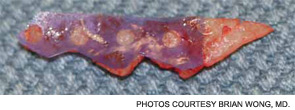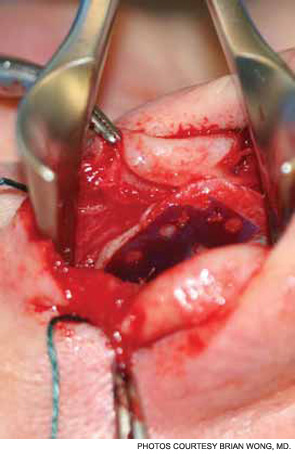Current indications for use, he said, include repair of severe caudal septal deviations, in operations that involve fractured pieces of cartilage that need stabilization or reconstitution and in select applications in rhinoplasty such as attachment of caudal septal extension grafts and in the salvage of smaller cartilage specimens for use as spreader grafts and even columellar struts.
Explore This Issue
August 2011These indications highlight two main advantages of the PDS plate in specific situations. Along with providing stability to cartilage, an added value of the PDS plate is that it reduces the surgeons’ need to rely on additional cartilage grafting, said Dr. Wong, who has been involved in National Institutes of Health-funded research on cartilage for over a decade while also serving as a paid consultant for Johnson & Johnson, the company that manufactures the implant through its subsidiary Ethicon, Inc.
"I think there are definite areas where [the PDS plate] can save you an immense amount of time," Dr. Wong said. "A major value is that the PDS plate allows you to piece together cartilage segments that are fragmented to make a larger component that can be done in structural or limited load-bearing conditions. As such, you can reduce the reliance upon secondary sources of cartilage like from the ear or rib."

Below: A patient undergoing surgery. The specimen was used as a spreader graft in a non-load bearing application.

Dr. Wong uses mainly the 0.15 mm perforated plate because the holes facilitate some nutrient supply to the cartilage in the time interval before the plate dissolves. He is currently examining the biomechanical effects of various plate thicknesses on cartilage mechanical behavior. He said that he believes the implant may be most valuable when used to correct convex lower lateral cartilages during rhinoplasty, although he said he doesn’t have extensive experience with this particular application yet.
Dean M. Toriumi, MD, professor of facial plastic and reconstructive surgery at the University of Illinois at Chicago, said the implant can be used for correcting severe septal deformities and deviations as well as for select applications of rhinoplasty. He said he has found it to be an excellent implant to temporarily splint cartilage or cartilage grafts in cases, for example, where the cartilage is cross-hatched. He prefers the 0.25 mm plate because of its combined relative strength and because its relative thinness avoids placing too much polymer at the surgical site.
Leave a Reply